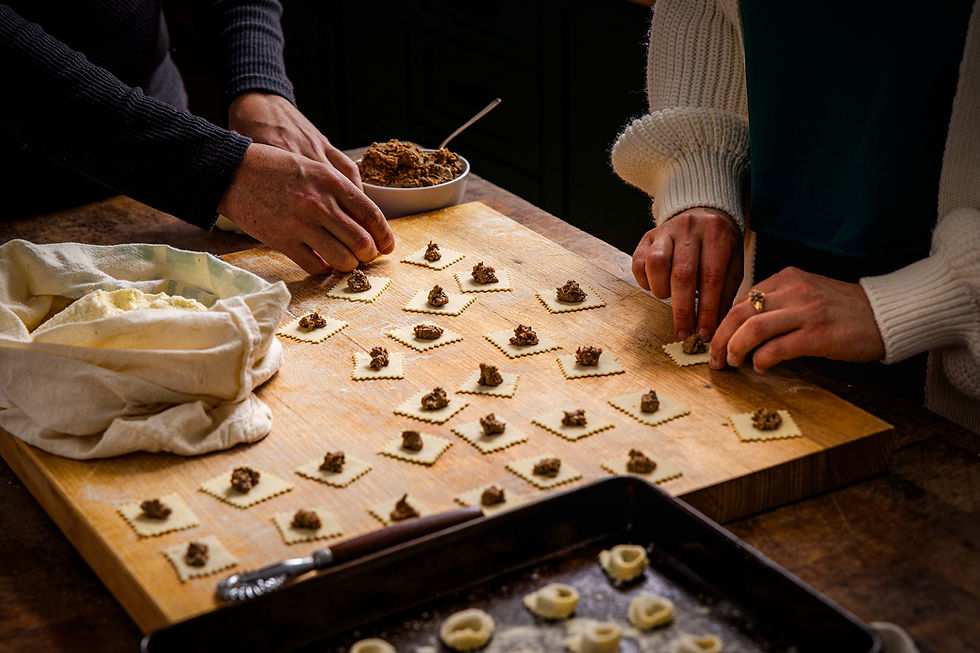Italian cooking: timeless skills and traditions for the future
- Nadia Fragnito

- Jan 3
- 3 min read
Traditional Italian home cooking provides the wisdom and skills we need to navigate a world that is increasingly losing touch.

There is something rather soothing about cooking traditional Italian food in 2025. It provides an antidote to a modern world that stubbornly refuses to slow down. A balm for our world-weary souls. It's a food culture that unapologetically insists on traditional recipes and methods. Italian home-style cooking opens a portal to the past. And it is these earlier times I'm yearning for more than ever.
Italian cuisine evolved from an era when home cooks did clever things with their produce and ingredients. They used their hands and homemade tools to knead, roll and shape. They ate seasonally and preserved Mother Nature's abundance with care and skill. They knew things about growing and storing food, and foraging when times were tough.

The Italian recipes we cook today have been passed down through generations and are often the exact replicas of their original versions. So when we whip up Italian food, we nurture this connection to the past. We too get to be the custodians of this knowledge and practice.
One of my favourite ways to connect to this wisdom, is to make pasta from scratch. This time-hungry occupation feels like a preposterous activity to undertake in our overstretched schedules. To create a meal that takes hours to prepare, and yet only minutes to eat. Oh the cheek of it! But it is precisely this fact that makes it an essential act of rebellion against our speed-junkie society.

Shaping pasta also improves our handicraft skills, a dexterity we may be at risk of losing. The mastery required to create handmade shapes like tortellini, orecchiette or trofie can only be forged through time, attention and repetition. Yet with our phones dinging, advertising blaring and fragmented minds racing, such an activity can seem indulgent, as if we're ignoring the 'real world' and its demands. It might seem like hyperbole, but the act of making pasta is a way to reclaim our human right - to step back into our bodies and move with a natural flow and rhythm. To also improve our precious fine motor skills. I'm sure I'm not the only one whose handwriting has deteriorated over years from technology use. We must recognise the (false) guilt that simmers within us when we dedicate considerable time in tactile food play - instead of answering all those emails, balancing online budgets or loading the dishwasher.
While we struggle to pay the bills and find ways to cut back on spending, southern Italian customs demonstrate how to reframe the way we shop and eat. History is here to help. In regional Italian home cooking, one loaf of bread is a precious resource. Once old and stale, the bread doesn't end up in the food waste pile or compost. It is stuffed into vegetables (peperoni ripieni), added to thicken soups (ribollita), rolled into dumplings (canederli). Crusts can be crumbled and fried (pangrattato) and sprinkled over pasta instead of cheese . Bread can be stored dried or frozen.
Traditional Italian recipes rarely require an expensive or expansive list of ingredients. On the contrary, they are few and simple. When I reflect on my nonna's cooking, she rotated the same tried and true recipes and the ingredients were humble, seasonal and affordable. Good food doesn't need to be complex. In contrast to today's recipes, because of our access to such variety, we can source almost any ingredient we take a shining to. If it's not on the supermarket shelves, we just buy it online. This has made contemporary cooking exhaustive and exhausting. And I can be a real sucker for this, especially when recipe testing. Just because we can, does it mean we should?
We can indeed uphold traditions that encourage our ingenuity, our resourcefulness - and our humanity. We can swim against the tide to avoid being swept too far out to sea. There is goodness that can be gleaned from the past. There is much to preserve and distill. Traditional Italian home cooking demonstrates this so beautifully, practically...and deliciously.
Here are a few recipes that honour traditions of the past.
RECIPES FOR SIMPLICITY


RECIPES THAT IMPROVE HANDICRAFT












Oooh,Gnocchi sounds great….😛